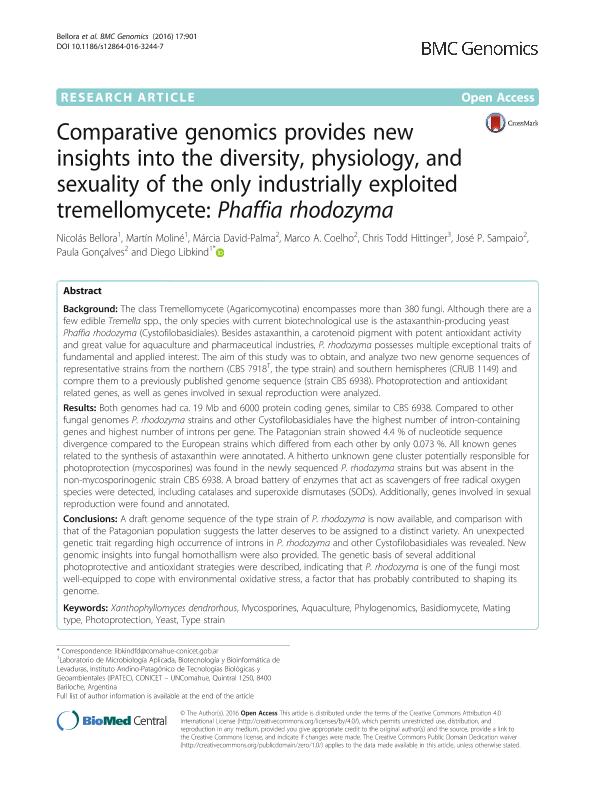Artículo
Comparative genomics provides new insights into the diversity, physiology, and sexuality of the only industrially exploited tremellomycete: Phaffia rhodozyma
Bellora, Nicolás ; Moline, Martin
; Moline, Martin ; David Palma, Márcia; Coelho, Marco A.; Hittinger, Chris Todd; Sampaio, José P.; Gonçalves, Paula; Libkind Frati, Diego
; David Palma, Márcia; Coelho, Marco A.; Hittinger, Chris Todd; Sampaio, José P.; Gonçalves, Paula; Libkind Frati, Diego
 ; Moline, Martin
; Moline, Martin ; David Palma, Márcia; Coelho, Marco A.; Hittinger, Chris Todd; Sampaio, José P.; Gonçalves, Paula; Libkind Frati, Diego
; David Palma, Márcia; Coelho, Marco A.; Hittinger, Chris Todd; Sampaio, José P.; Gonçalves, Paula; Libkind Frati, Diego
Fecha de publicación:
11/2016
Editorial:
BioMed Central
Revista:
BMC Genomics
ISSN:
1471-2164
Idioma:
Inglés
Tipo de recurso:
Artículo publicado
Clasificación temática:
Resumen
Background: The class Tremellomycete (Agaricomycotina) encompasses more than 380 fungi. Although there are a few edible Tremella spp., the only species with current biotechnological use is the astaxanthin-producing yeast Phaffia rhodozyma (Cystofilobasidiales). Besides astaxanthin, a carotenoid pigment with potent antioxidant activity and great value for aquaculture and pharmaceutical industries, P. rhodozyma possesses multiple exceptional traits of fundamental and applied interest. The aim of this study was to obtain, and analyze two new genome sequences of representative strains from the northern (CBS 7918T, the type strain) and southern hemispheres (CRUB 1149) and compre them to a previously published genome sequence (strain CBS 6938). Photoprotection and antioxidant related genes, as well as genes involved in sexual reproduction were analyzed. Results: Both genomes had ca. 19Mb and 6000 protein coding genes, similar to CBS 6938. Compared to other fungal genomes P. rhodozyma strains and other Cystofilobasidiales have the highest number of intron-containing genes and highest number of introns per gene. The Patagonian strain showed 4.4% of nucleotide sequence divergence compared to the European strains which differed from each other by only 0.073%. All known genes related to the synthesis of astaxanthin were annotated. A hitherto unknown gene cluster potentially responsible for photoprotection (mycosporines) was found in the newly sequenced P. rhodozyma strains but was absent in the non-mycosporinogenic strain CBS 6938. A broad battery of enzymes that act as scavengers of free radical oxygen species were detected, including catalases and superoxide dismutases (SODs). Additionally, genes involved in sexual reproduction were found and annotated. Conclusions: A draft genome sequence of the type strain of P. rhodozyma is now available, and comparison with that of the Patagonian population suggests the latter deserves to be assigned to a distinct variety. An unexpected genetic trait regarding high occurrence of introns in P. rhodozyma and other Cystofilobasidiales was revealed. New genomic insights into fungal homothallism were also provided. The genetic basis of several additional photoprotective and antioxidant strategies were described, indicating that P. rhodozyma is one of the fungi most well-equipped to cope with environmental oxidative stress, a factor that has probably contributed to shaping its genome.
Archivos asociados
Licencia
Identificadores
Colecciones
Articulos(INIBIOMA)
Articulos de INST. DE INVEST.EN BIODIVERSIDAD Y MEDIOAMBIENTE
Articulos de INST. DE INVEST.EN BIODIVERSIDAD Y MEDIOAMBIENTE
Articulos(IPATEC)
Articulos de INSTITUTO ANDINO PATAGONICO DE TECNOLOGIAS BIOLOGICAS Y GEOAMBIENTALES
Articulos de INSTITUTO ANDINO PATAGONICO DE TECNOLOGIAS BIOLOGICAS Y GEOAMBIENTALES
Citación
Bellora, Nicolás; Moline, Martin; David Palma, Márcia; Coelho, Marco A.; Hittinger, Chris Todd; et al.; Comparative genomics provides new insights into the diversity, physiology, and sexuality of the only industrially exploited tremellomycete: Phaffia rhodozyma; BioMed Central; BMC Genomics; 17; 1; 11-2016; 1-16
Compartir
Altmétricas



